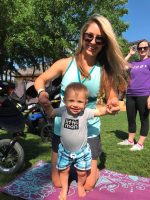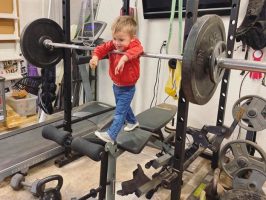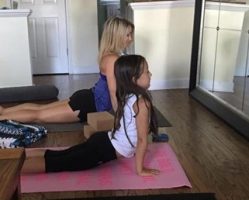Making Movement a Family Affair
Most mornings, I tiptoe past two of my four kids on the way to my garage gym. These two – the “big boys” – are content to sit in front of the TV, watching cartoons and munching on moderately sugary cereal while my 18-month-old son and my preteen stepdaughter sleep in. If they spot me (and they usually do), I give each boy a quick kiss on the cheek, refill someone’s milk, lace up my shoes, and head into my daily 20-minute sweat session.

Anyone could criticize how I balance parenting and staying active: be it the Cocoa Puffs, the screen time, or the brevity of my morning fitness program. Before I had kids, I might have said: “We make time for what matters!” without regard for the dearth of “free time” available before and after work, which is spent taxiing kids to and from school, tutoring them on homework, keeping the peace among siblings, preparing nutritious-ish meals, limiting screen time, and being intercepted by the inevitable work crisis just before someone unveils a mysterious rash. We’ll deal with the rash later though. Right now I want to impart one very important idea: We normalize a healthy and active lifestyle with our consistent actions.
When I became a new mom, my football coach husband was gone between 11 to 15 hours a day, leaving me with a colicky newborn and no opportunity for someone else to hold the baby so I could break a sweat. I knew that if I was going to stay active (and sane), I had to orchestrate my day so that I could move in a way that felt good to me. At the time, I didn’t realize I was laying a foundation for my kids to see exercise not as an activity we engage in to look good or win medals, but a habit we establish to take care of our well-being.
Start ‘em Young (If You Can)
 About five days after my first birth via cesarean section, I was pushing my newborn around the block. I was slow, but I was moving. Once I was cleared by my doctor for more strenuous exercise, we joined a Fit4Mom Stroller Strides Group, which gave us the sense of community support we needed as we adjusted to our newly intertwined routines. As my baby grew into a verbal toddler, he started asking to come with me on a run – even if my husband was home and we didn’t have a fitness class to attend. He’d grown accustomed to the fresh air and sightseeing offered by a jaunt in the jogging stroller.
About five days after my first birth via cesarean section, I was pushing my newborn around the block. I was slow, but I was moving. Once I was cleared by my doctor for more strenuous exercise, we joined a Fit4Mom Stroller Strides Group, which gave us the sense of community support we needed as we adjusted to our newly intertwined routines. As my baby grew into a verbal toddler, he started asking to come with me on a run – even if my husband was home and we didn’t have a fitness class to attend. He’d grown accustomed to the fresh air and sightseeing offered by a jaunt in the jogging stroller.
Get Outside
 If you don’t have a jogging stroller or your kids are too big to be pushed in one, challenge yourself to get outside. This strategy is especially helpful over long weekends and holiday breaks as the broken record of boredom sets in. Let your kids pick a nearby state park, help you pack lunch, and then get in the car before anyone changes their mind. If you need to stay close to home, find a local park you haven’t explored yet. See if you can visit every park in town. Or get your body moving around your own yard. Bending over to deadhead last year’s chrysanthemums or moving landscaping rock is one of my favorite ways to sneak in functional fitness, and young kids don’t see gardening as a chore.
If you don’t have a jogging stroller or your kids are too big to be pushed in one, challenge yourself to get outside. This strategy is especially helpful over long weekends and holiday breaks as the broken record of boredom sets in. Let your kids pick a nearby state park, help you pack lunch, and then get in the car before anyone changes their mind. If you need to stay close to home, find a local park you haven’t explored yet. See if you can visit every park in town. Or get your body moving around your own yard. Bending over to deadhead last year’s chrysanthemums or moving landscaping rock is one of my favorite ways to sneak in functional fitness, and young kids don’t see gardening as a chore.
Get in the Game
 Being part of a team gives kids a sense of belonging, which is especially important for their identity development as they transition from middle school to high school. You want to start with a sport that feels accessible to your child, but stay open to trying new sports over the years. As a coach’s wife, I am all-too-familiar with the dangers of overspecialization. I wouldn’t want my kids to feel pressure to be the best, to overtrain, or to associate moving their body with negative physical and mental outcomes. Let your kid sample different sports until they figure out what feels good to them.
Being part of a team gives kids a sense of belonging, which is especially important for their identity development as they transition from middle school to high school. You want to start with a sport that feels accessible to your child, but stay open to trying new sports over the years. As a coach’s wife, I am all-too-familiar with the dangers of overspecialization. I wouldn’t want my kids to feel pressure to be the best, to overtrain, or to associate moving their body with negative physical and mental outcomes. Let your kid sample different sports until they figure out what feels good to them.
Practice What You Preach
 Even when we think they’re not paying attention, kids are always watching. If you really want your child to internalize the values of an active lifestyle, they need to see engaging in exercise you genuinely enjoy. Running is my sport, so I tote my family along to a handful of 5Ks each year. My husband in his size-13 shoes used to hate running, but now he loves the social spectacle of a race. We make it fun with music, festive outfits, and a cornucopia of snacks. If you don’t know what your preferred form of exercise is just yet, experiment until you do. Find what you love, but don’t force your kids to love it, too. Just show up for yourself, and you might notice them showing up for themselves in the future, too.
Even when we think they’re not paying attention, kids are always watching. If you really want your child to internalize the values of an active lifestyle, they need to see engaging in exercise you genuinely enjoy. Running is my sport, so I tote my family along to a handful of 5Ks each year. My husband in his size-13 shoes used to hate running, but now he loves the social spectacle of a race. We make it fun with music, festive outfits, and a cornucopia of snacks. If you don’t know what your preferred form of exercise is just yet, experiment until you do. Find what you love, but don’t force your kids to love it, too. Just show up for yourself, and you might notice them showing up for themselves in the future, too.
Cue. Routine. Reward.
 Dealing with resistance? Let me give you the TLDR note on the book The Power of Habit: Cue. Routine. Reward. That is, we establish cues that prompt a desired behavior (the routine), and a sustainable reward system.
Dealing with resistance? Let me give you the TLDR note on the book The Power of Habit: Cue. Routine. Reward. That is, we establish cues that prompt a desired behavior (the routine), and a sustainable reward system.
Here’s a recent example. Most days I would rather do cardio over lifting weights any day, but on Sundays I drag myself to our garage gym, and I pop open a tropical cherry sparkling water, pausing for a sip after each set. It’s refreshing and simple, but it gets me out of my comfort zone, and under a barbell.
Talk it Out
 Through exercise we find challenge, and through challenge we test our mettle. More than once, my kids have heard me huffing and puffing up a hill, repeating to myself: “A hill is only half bad.” This expression demonstrates an outlook on life I hope they will adopt one day, when the need arises.
Through exercise we find challenge, and through challenge we test our mettle. More than once, my kids have heard me huffing and puffing up a hill, repeating to myself: “A hill is only half bad.” This expression demonstrates an outlook on life I hope they will adopt one day, when the need arises.
And finally, talk with your kids about why you move to improve your physical, mental, and emotional well-being, but be mindful of how diet culture emphasizes restriction, unrealistic standards, and negative self-talk. Our kids are always listening, so before you appraise your own appearance or performance, ask yourself, “Would I want my children to say this to themselves?”


 Sign in
Sign in

